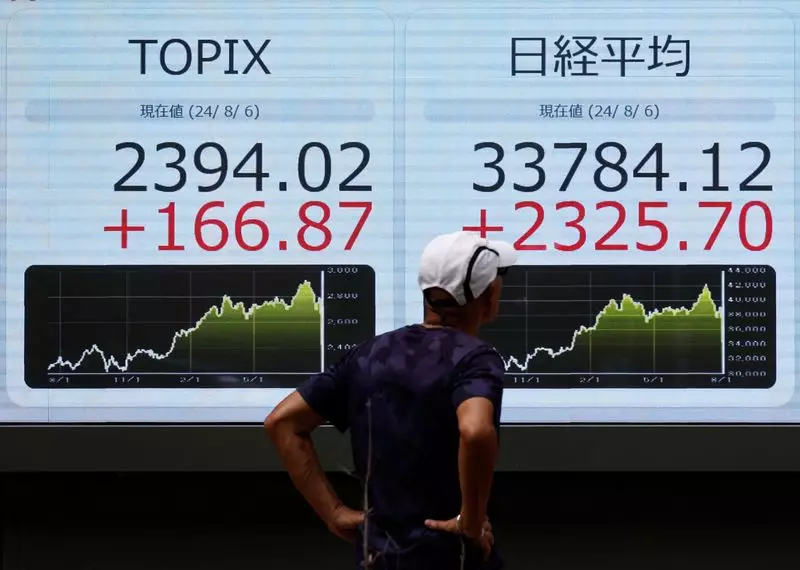Asian stock markets have recently reached noteworthy milestones, achieving their highest levels in over two months. This surge follows broadly optimistic expectations around the potential for monetary easing from the U.S. Federal Reserve. As global investors enter a climate gripped by inflation and interest rate anxiety, all eyes are on central banks and their responses to these continuously shifting economic parameters. With Australia’s Reserve Bank set to announce its policy direction soon, the anticipation surrounding these events reflects a broader trend of cautious optimism in the region.
The resurgence in Asian financial markets can be attributed to various factors, including strategic movements by influential economies like China, which is engaged in multiple efforts to stabilize its economic growth. In the past few days, Chinese financial authorities introduced pivotal measures aimed at revitalizing the country’s economy, notably through cuts to mortgage rates on existing properties. Such moves are integral in restoring consumer confidence amid signs of economic deceleration.
While Asian markets are buoyant, the Reserve Bank of Australia’s (RBA) imminent decision on interest rates remains highly anticipated. Analysts predict that the RBA will maintain its current hawkish stance, choosing to keep interest rates steady for now, despite recent shifts in global financial conditions. Charu Chanana, head of currency strategy at Saxo, indicates that the RBA could consider altering its approach in the coming months, particularly after analyzing new labor market data in conjunction with upcoming consumer price index reports.
The dynamics at play here suggest a balancing act; the RBA aims to maintain consumer inflation expectations while acknowledging the ripple effects of U.S. monetary policy on Australia’s economy. The recent cut by the Federal Reserve—50 basis points—has stirred speculation that similar actions could be considered by other central banks in due course, even as the RBA cautiously withholds immediate adjustments.
The unwavering nature of market stability in Asia mirrors cautious optimism. The MSCI index encompassing Asia-Pacific shares, excluding Japan, recently registered an increase, signaling that investors are positively responding to the shifts occurring globally. Japan’s Nikkei index, notable for its significant uptrend, reflects a similar attitude. As it nears a three-week high, market observers are keenly awaiting remarks from the Bank of Japan’s Governor Kazuo Ueda, expecting insights that may influence regional market sentiment.
Despite the overall market positivity, there remain underlying tensions in the U.S. economy. The Federal Reserve’s actions have been pivotal in directing market expectations, with a split sentiment on whether another significant cut—or a more moderate adjustment—will take place during its November meeting.
The upcoming non-farm payrolls report scheduled for October 4 stands as a looming factor that could significantly sway market perceptions. Financial strategists believe that robust job growth could lead to a tightening of monetary policy, while weaker data may lend credence to expectations of sustained easing. As such, current market valuations incorporate a blend of hopes for a dovish U.S. Federal Reserve alongside the realities of a potent economic environment.
Market participants are increasingly wary of the U.S. dollar’s performance, particularly against emerging currencies that are more sensitive to growth projections. The dollar index remains near one-year lows, indicating broader market sentiments favoring riskier currencies. Meanwhile, the euro has also experienced fluctuations following disappointing economic reports from the eurozone, raising further considerations for ongoing rate adjustments by the European Central Bank.
Amidst these financial adjustments, commodities like oil are presenting heterogeneous signals. Current price movements show slight increases with Brent crude trading upwards following recent declines attributed to subdued demand forecasts and lackluster economic data from Europe. This dynamic suggests that while equities exhibit optimism, the overall economic landscape continues to reflect uncertainty, defining the challenges in commodity markets.
As Asia’s financial markets bask in positive momentum with central banks contemplating their next strategic moves, investors remain vigilant. The interplay between U.S. monetary policy, regional responses, and economic indicators will undoubtedly shape market outcomes in the weeks to come, determining not just the trajectory of stocks but also the health of the global economy.

